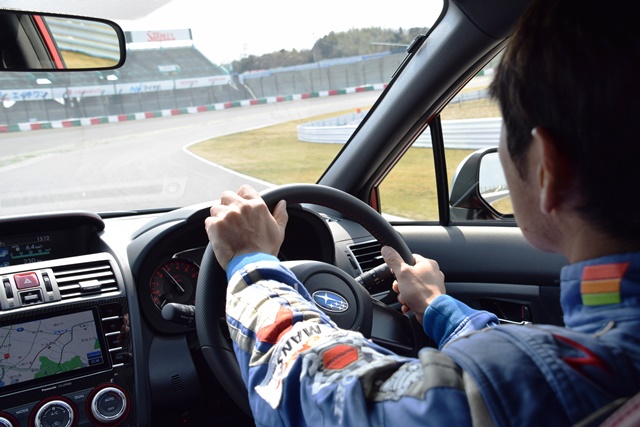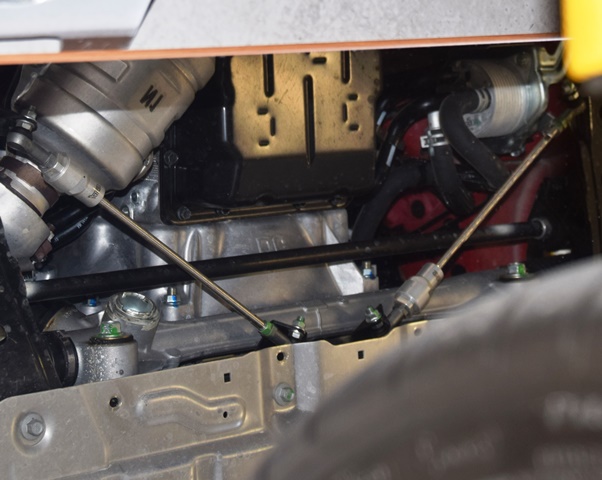SUZUKA, Japan – There’s a horsepower war raging in the streets, but Subaru will not amass troops of engineers on the border, provoke their rivals with claims of powertrain superiority or participate in any way.
Instead, one of Japan’s fastest-growing automakers is concentrating its resources on allowing driving enthusiasts – a core audience vital to Subaru’s future – to better use the ample horsepower and torque currently available in production vehicles.
That means an emphasis on chassis dynamics and crisp steering for those customers who appreciate great handling and aggressive cornering and may even race on weekends.
The strategy takes shape this week at the New York International Auto Show as Subaru unveils an STI concept car that signals the availability of a range of aftermarket parts patented by Subaru and designed to pique the curiosity of performance-oriented consumers.
“We aim to make a car that becomes an extension of our body so the driver can take the car to the limit with peace of mind,” Yoshio Hirakawa, president of Subaru Tecnica International, tells journalists here. “For this, we believe transient characteristics are very important.”
Hirakawa says the U.S. market is vital for repositioning and growing the STI brand. Subaru’s fiscal-year vehicle sales have grown from 555,000 in 2009 to 825,000 last year, and the U.S. far-and-away represents Subaru’s No.1 market, representing more than 50% of global deliveries.
STI is best known in the U.S. as a big-winged variant of the WRX, which is a modified Impreza, but the automaker wants Americans to start thinking of STI as a high-performance engineering division akin to BMW’s M and Mercedes’ AMG units.
The strategy begins at the New York show as Subaru rolls out the STI Performance Concept to leverage its three core business areas: aftermarket parts, STI-tuned cars and motorsports.
The modified BRZ concept features a large carbon-fiber spoiler among other aerodynamic upgrades, as well as beefed-up suspension and chassis components and a racing engine developed by STI for the BRZ Super GT.

Don’t count on seeing this track-ready lowrider at a Subaru showroom anytime soon. For the near term, the STI business plan will focus on expanded aftermarket parts. But Subaru executives here say a modified BRZ carrying STI badging will go on sale at some point.
The NY concept is slathered with lightweight carbon fiber, including the side-view mirrors, steering wheel, rocker panels, rear fascia and instrument panel.
STI Through the Years
The concept is intended to showcase STI’s engineering prowess and tuning capability. The division was formed in 1988 and has some 80 employees, including 50 engineers, at offices in Tokyo and Gunma prefectures.
STI always has been aligned closely with Subaru’s motorsports activities and later expanded into aftermarket parts and then complete vehicles. The first STI model, a Legacy Touring wagon, was limited to 200 units in the home market in 1992.
More recently in the U.S., the WRX STI has been a tightly sprung lightweight hatchback or sedan making at least 300 hp and immediately recognized for its large rear wing. The car’s moderate price tag and all-wheel drive have made it popular among young male rally fans over the years. For a short time, the car was known solely as the STI, without the WRX prefix.
But Japan and a few other markets have seen a wider array of limited-edition performance variants getting the STI treatment, such as the Legacy tS, Forester tS and BRZ tS.
Again, it’s not about additional horsepower or torque but the application of patented STI-designed chassis and suspension hardware, such as front flexible tower bars, flexible draw stiffeners at both the front and rear, pillow-ball bushings at the rear and a flexible support rear subframe.

On a handling track, the goal of this technology is to achieve faster response to yaw and lateral forces and reduce pitch and the propensity for body roll. And even though a vehicle’s steering ratio remains unchanged, the hardware also can result in faster steering response.
Likewise, an automatic transmission controller can be tweaked for closer gear ratios to get the driver more quickly to the meat of the engine’s powerband.
All of these enhancements become plain as day during test drives of identical vehicles with and without the technology at Japan’s famous race track here, the Suzuka Circuit, home to many race series, including Formula One.
Right-hand-drive test vehicles include unaltered factory editions of the BRZ coupe and Forester CUV, as well as the tS variants evaluated back to back.
Modified Versions Great Fun at Track
The standard BRZ handles reasonably well. But the modified tS version, with the same 2.0L naturally aspirated 4-cyl. boxer and the additional chassis and suspension hardware, feels like a different car, capable of carrying a lot more speed into a corner with greater stability.
Same for the Forester, a 5-passenger ute that almost never will be driven this aggressively with its 2.0L turbocharged boxer-4. But it’s good to know you can, with a fair degree of confidence, in the tS model.
Of course, the WRX STI is at the track, and there are three versions for thrashing. The first two are the previous generation (S206) with additional tS suspension bits and the latest model, all stock, which launched last year. Each model uses the same 2.5L turbo-4 rated at 305 hp.
The star of the event, until it is sidelined with a wonky clutch, is a prototype WRX STI with a 2.0L turbocharged boxer-4, an all-new chassis, bigger brakes, wider tires and stiffer coil springs, while using production dampers.
Subaru says the prototype is 40% stiffer than the current WRX STI, which is readily apparent on the track, and the car understeers less. In addition, front suspension components are inverted to further resist lateral forces.
Most remarkable is how much more enjoyable all the modified vehicles are to drive with the addition of certain suspension and chassis hardware. Test drives are limited to the track, but the improvements clearly would be appreciated on public roads as well.
With a focus on ride and handling, Hirakawa says there is no plan to increase horsepower or torque ratings in STI-badged vehicles. Once the expanded STI business plan takes root sometime in the future, he says the automaker will consider boosting engine output.
More immediately, Subaru is focusing on making some of these STI parts available online and through dealers.

Aftermarket performance parts that had been branded Subaru Performance Tuning (such as strut braces and cold-air intakes) soon will carry the STI name.
After years as an interesting offshoot, the STI division now is strategically integrated within Subaru’s long-term business plan, known as Prominence 2020.
Once the aftermarket parts start generating more revenue, the vision is to offer complete vehicles “tuned by STI” with modifications to the exterior, interior and, of course, chassis and suspension.
For Hirakawa, that day can’t come soon enough in the STI gameplan. “The complete car is our first priority in the U.S.,” he says.





